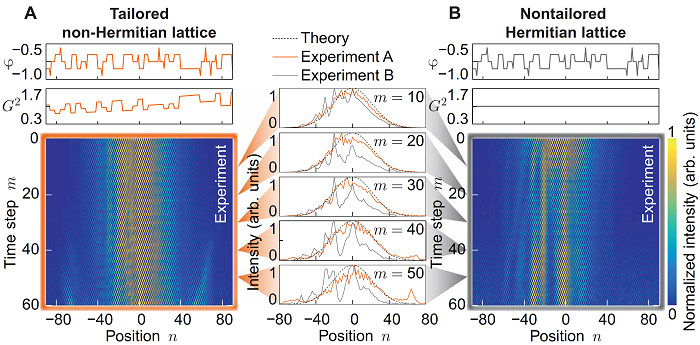This website uses cookies to ensure a better user experience.
To get more information, please read our Cookie Statement.
Observation of photonic constant-intensity waves and induced transparency in tailored non-Hermitian lattices
Our colleague Ivor Krešić has theoretically developed a method for removing scattering in inhomogeneous time-multiplexed fiber loop photonic lattices. The method relies on controlling the phase and amplitude of electromagnetic waves by inserting non-Hermitian elements into the lattice. Colleagues from the University of Rostock (Germany) implemented this method in an experimental system of synthetic disordered photonic lattice created using laser pulses propagating inside optical fibers.
Observation of photonic constant-intensity waves and induced transparency in tailored non-Hermitian lattices
Andrea Steinfurth, Ivor Krešić, Sebastian Weidemann, Mark Kremer, Konstantinos G. Makris, Matthias Heinrich, Stefan Rotter, Alexander Szameit
Science Advances 8 (21), eabl7412 (2022)
The propagation of light in an inhomogeneous medium is largely determined by scattering, which in the case of strong system disorder can cause the ordered initial laser beam to completely lose its shape after entering the medium. Such highly disordered media are also found in our environment, e.g. a milk glass or mist, and prevent the spread of information via light.
Figure 1: Experimental realization of undistorted Gaussian beam propagating through a discrete non-Hermitian medium. (A) Using the method developed in this article, the disordered discrete optical grating has been modified in such a way as to allow propagation of the Gaussian beam without scattering and diffraction over long distances. (B) An unmodified grid causes the initial beam to deform by branching into smaller parts.
Using the method developed in this paper, inspired by similar methods in continuous media, it is possible to determine the exact configuration of optical losses and gains that needs to be added to a discrete synthetic photonic grating to completely eliminate the effect of scattering on beam propagation. Experiments conducted in a laboratory at the University of Rostock have shown that the method is applicable even to highly disordered initial gratings, in which the degradation of the incident Gaussian beam by branching into smaller parts is present (Figure 1). These findings may facilitate future discoveries on the application of non-Hermitian optics for the control of light propagation through space.





